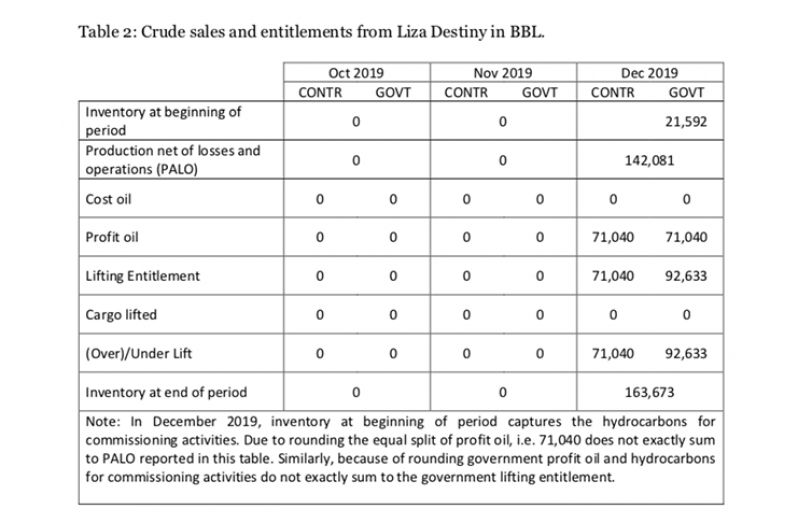IN keeping with rules set out in the Natural Resource Fund (NRF) Act 2019, the Ministry of Finance has released Guyana’s first Report on Petroleum Production and Revenues (RPPR) for the period of December 2019.
The report was released on Monday and is based on various reports provided to the government by ExxonMobil with all reasonable efforts made to verify the accuracy of the report. It showed that a total of 163,673 barrels of the crude on the FPSO facility at the end of December 2019 was available to be lifted. However, during December 2019, no oil was lifted from Liza Destiny since the volume available for lifting was less than the standard cargo size of 1,000,000 barrels.
SALE AND ENTITLEMENT
With no petroleum sold in December 2019, all petroleum produced in that month was allocated to profit oil, of which the government will be entitled to half. The government’s entitlement was half of the production net of losses and operations (PALO) in that month plus an onboard inventory of 21,592 barrels of Marine Gas Oil (MGO) and Intermediate Fuel Oil (IFO) present before the start of production.
This was the remaining fuel that was loaded to power the FPSO facility for the journey from Singapore and for the commissioning of subsea risers and flowlines. Therefore, while the contractor would receive 71,040 barrels, the government would receive 92,633 barrels.
The report explained that since the government did not lift its December 2019 entitlement, this amount is credited to an (Over)/Under Lift account which keeps track of all barrels of crude owed to parties. “Since cargoes are lifted 1,000,000 BBL at a time in any given month there will be some parties that have lifted more than their entitlement and some that have lifted less. Entitlements are reconciled with actual lifts in the (Over)/Under Lift account and brought forward to the next month,” the report explained.
It was also noted that since government has elected to receive its 2 per cent royalty in cash, this amount will be paid from the Contractor’s share of profit oil. The document stated: “As per Article 15.6 of the Petroleum Agreement for the Stabroek Block, the royalty cash payment for a calendar quarter will be made to government 30 days after the end of that quarter.”
Meanwhile, since no petroleum was lifted in December 2019, government earned no petroleum revenues for this month; there were no deposits made to the NRF.
PRODUCTION PROCESS

Details within the report also explained that before the amount available to be lifted stood at 163,673 barrels, total production of oil stood at 427,282 barrels for December 2019. Of the 427,282 barrels produced, a total of 3,202 barrels were used for facility fill, which includes the oil that remains in the various piping before the cargo tanks.
A further 282,000 barrels of oil produced in December 2019 was used for ballast in the cargo tanks. This is the minimum quantity of crude required to maintain stability of the FPSO facility. It was estimated that an additional 1,020 barrels will remain in the hose and piping between cargo tanks and the offloading hose point at the completion of the first lift — this figure is therefore not subtracted from the total production of oil.
This brought the production net of losses and operations (PALO) during December 2019 to 142,081 barrels which represents: 427,282 – 282,000 – 3,202. Add this PALO of 142,081 barrels to the onboard inventory of 21,592 and one arrives at 163,673 barrels of the crude available to be lifted. A one-unit discrepancy is noted in the reported and calculated values due to rounding. All barrels reported are rounded to the nearest barrel and prices to the nearest US cent. There were no operational losses reported for this period. However, the RPPR indicated that operational volumes will remain on the FPSO facility and in the piping until production from Liza Destiny has ceased.
NRF AS A GUIDE
Guyana became an oil producing nation on December 20, 2019 and, anticipating the same, the government set up a sovereign wealth fund (SWF) – also known as the NRF — to safeguard against the resource curse and to ensure that petroleum revenues benefit both current and future generations. The government has committed to managing the Fund according to international best practices such as the Santiago Principles. Meanwhile transparency and accountability will come from the publishing of several reports.
These include reports from the Public Accountability and Oversight Committee, Macroeconomic Committee and Investment Committee; reports on withdrawals from the NRF, to be included in the annual budget proposal and, if needed, in a Supplementary Appropriation Bill; annual reports of the NRF, including audited financial statements; quarterly reports and financial statements of the NRF and monthly reports of the NRF.
“These reports will allow the public to monitor deposits in, and withdrawals from, the NRF so as to ensure that petroleum revenues are being managed according to the provisions of the NRF Act 2019,” the report stated.
However, it was noted that information in these reports may be insufficient to allow persons to determine how government revenues that are deposited into the NRF are calculated. It is on this basis that the RPPR is being provided to bridge the gap by providing regular updates on petroleum production and revenues. Even so, the Ministry of Finance does not take responsibility for any errors or omissions included in the reports provided to the government.



.jpg)








